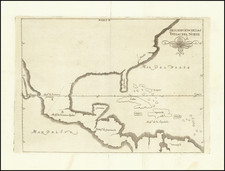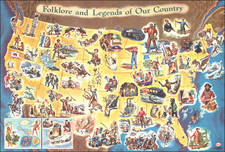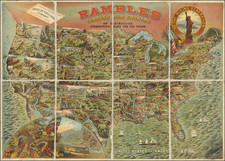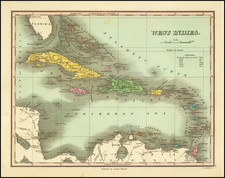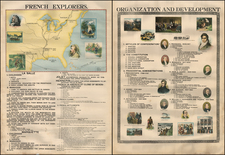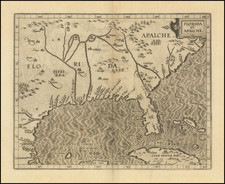The First General Map of The American Colonies, in Full Original Color.
Rare separate map of the British Colonies in America, published in London by Robert Morden and William Berry, with the engraving questionably ascribed to Wenceslaus Hollar.
First advertised in the London Gazette in June 1673, the map is significant for its depiction of English-American colonies from Hudson Bay to Guiana, being the earliest map to highlight England's overseas territories in America. Published shortly after Captain Henry Morgan sacked Panama City in December 1670 (an act for which he was knighted), the map emphasizes the breadth of the English colonial interests in America.
William P. Cumming notes that this is probably one of the earliest maps to use the information from John Lederer's map and reports of 1672. Believing that the riches of California and the Pacific lay just beyond the mountains west of Virginia, Sir William Berkeley, colonial governor of Virginia, commissioned Lederer to make three expeditions into the Appalachians between 1669 and 1670. Berkeley wanted him to find a passage to the West and the Indian Ocean, which Europeans believed was a few weeks' travel away. While unsuccessful in his quest for the Pacific Ocean, Lederer's explorations significantly improved the mapping of the region, for example, in showing the "Eruco R" as a tributary of the Roanoke River and including the Rickohockan Indians. The map also identifies Ashley Lake, a toponym that appeared first on John Ogilby's map of the Carolinas, which also derives from John Lederer's map.
"Baltemor[e] C[ounty]" is shown, as is "Cecil C[ounty]", both of which derive from Ogilby, the latter of which was officially created in 1674. Further north, the "Ile Manahattent" (Manhattan Island), is shown. Long Island is shown as a distinct Island, with four large lakes in the center, each draining to the south. Felis Lake is an early reference to the St. Lawrence River and Lake Erie, curiously placed immediately west of Maryland.
The configurations of Florida and the Gulf Coast are interesting, representing the sparse first-hand information available to the English, especially with respect to the Course of the Mississippi River, with 1673 being the year that Louis Jolliet and Jacques Marquette descended and mapped the Mississippi River for the first time.
The map emphasizes Jamaica's strategic importance, indicated by its central placement. The legends on the map underscore Jamaica's advantageous position relative to Panama and other areas, reflecting England's trade and colonial interests, particularly in relation to a potential trans-Isthmian trade route.
Rickohockans
There has been considerable debate over the identity and ethnicity of the Rickohockens over the years.
The reference on the map derives from Lederer, who noted:
I have heard several Indians testifie, that the Nation of Rickohockans, who dwell not far to the Westward of the Apalataean Mountains, are seated upon a Land, as they term it, of great Waves; by which I suppose they mean the Sea-shore.
The next day after my arrival at Akenatzy, a Rickohockan Ambassadour, attended by five Indians, whose faces were coloured with Auripigmentum (in which Mineral these parts do much abound) was received, and that night invited to a Ball of their fashion; but in the height of their mirth and dancing, by a smoke contrived for that purpose, the Room was suddenly darkned, and for what cause I know not, the Rickohockan and his Retinue barbarously murthered. This struck me with such an affrightment, that the very next day, without taking my leave of them, I slunk away with my Indian Companion. Though the desire of informing my self further concerning some Minerals, as Auripigmentum, &c. which I there took special notice of, would have perswaded me to stay longer amongst them, had not the bloody example of their treachery to the Rickohockans frighted me away.
States of the Map & Rarity
There are three known states of the map:
- State 1 (1673): Proof state, with the map in an incomplete form, for example, lacking the shading along the coastline, and with many names omitted. Omitting the note about "The Rickohockans" west of the Appalachian Mountains and Felis Lake to the left of the Coat of Arms
- State 2 (1673/1677): Hollar's name removed. Place names added, as above.
- State 3 (circa 1675): Along the Maryland and New Jersey coast the following names have been inserted: 'Barngat' (revised from 'Barnegat' and re-positioned), 'Egg Harbour', 'Bear hole' and 'Cape Hinlope[n]'. Other changes were made.
The first state is known in a single example in the Stokes Collection, New York Public Library.
RBH notes three examples offered for sale in the past 30 years, two of which were heavily damaged and restored.
Robert Morden (d. 1703) was a British map and globe maker. Little is known about his early life, although he was most likely apprenticed to Joseph Moxon. By 1671, Morden was working from the sign of the Atlas on Cornhill, the same address out of which Moxon had previously worked. Most famous for his English county maps, his geography texts, and his wall maps, Morden entered into many partnerships during his career, usually to finance larger publishing projects.









